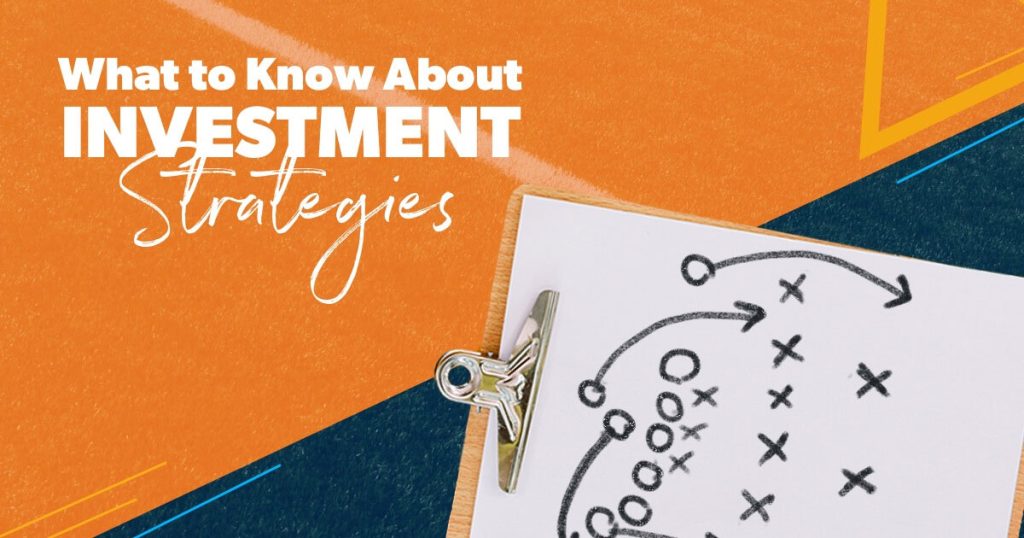A solid investment strategy gives you focus, clarity and direction—and you need all three to become a successful investor. You need to have an investment strategy that’s going to help turn your retirement dreams into a reality.
Your investment strategy matters. The right strategy will help you make the right decisions so that you can get the right results. Successful businesses, championship sports teams, award-winning organizations . . . they all have a clear strategy in place that helps them pile up wins.
What Is Investment Strategy?
Think of your investment strategy as a guide to help you make investing decisions. Your strategy is based on your retirement goals and dreams, how much risk you’re willing to take, and how much money you need to reach your retirement goals. Before you make any investment decision, you should ask yourself: Does this fit my overall strategy?
Why do you need an investment strategy? Because without a strategy, you’ll be pulled in a hundred different directions and end up going nowhere. Your investment strategy won’t just help you figure out what to do, but also what not to do. And that’s just as important!
What Are Some Investment Strategy Principles to Abide By?
OK, before we look at some of the most common investment strategies out there, we want to take a minute to talk about some investing principles first. These principles should serve as the foundation of your strategy:
- Keep a long-term perspective. Investing is a marathon, not a sprint. The stock market will have its ups and downs but remembering the big picture will help you keep your cool when the stock market is going through a hiccup. The only people who get hurt on a roller coaster are the ones who jump off—so sit tight and keep moving forward!
- Take advantage of tax-advantaged accounts. Tax-deferred accounts like your traditional 401(k) or 403(b) help you get a tax break now. Tax-exempt accounts like a Roth IRA help your money grow tax-free and allow you to make tax-free withdrawals in retirement. Both types of accounts can help you save for retirement with some nice tax benefits!
- Be consistent. Consistency is the key to building wealth over time. There are no shortcuts! If you invest 15% of your gross income into your 401(k)s and IRAs month after month, year after year, don’t be surprised if you look up one day and see your account balance reach the seven-figure mark.
- Focus on growth. When you’re saving for retirement, there’s an enemy you’re trying to outrun. That enemy has a name, and it’s called inflation. That means a dollar today is going to feel more like 75 cents a decade from now. You need to invest your money in a way that outpaces inflation so your money goes further in retirement.
- Reduce your risk with diversification. You’ve probably heard the phrase “Don’t put all your eggs in one basket” before. That’s all diversification is! There’s always going to be some element of risk when you’re investing in the stock market, but you can reduce your risk by spreading out your investments evenly between four different types of mutual funds: growth and income, growth, aggressive growth, and international.
What Are the Most Common Investment Strategies?
Now that we’ve established some of the principles that will be the foundation of your investment strategy, it’s time to take a look at which strategies will put you in the best position to reach your retirement goals.
Market chaos, inflation, your future—work with a pro to navigate this stuff.
Just a heads up: You’re going to notice that your overall investment strategy might be a combination of several of these strategies! Having the right strategies together will help you reach your retirement and investing goals.
Let’s dive into five of the most common investment strategies out there and which ones make the most sense based on the principles I talked about earlier.
Investment Strategy #1: Value Investing
Value investors are the coupon-clipping bargain hunters of the investing world. They buy stocks that appear to be trading for less than what they’re really worth. They’re willing to bet that these stocks are being underestimated by the stock market and will bounce back over the long run. As those stocks grow in value, they turn a profit for the investor.
For example, let’s say there’s a company out there that’s going through a bit of a rough patch—we’ll call it ACME, Inc. The company didn’t sell as many widgets last quarter as they expected, and that caused their stock price to fall from $100 to $75.
But Mark is an investor with a value investing strategy who still believes ACME stock’s true value is $100. He sees this as an opportunity to buy stock at a discount, so he buys in for $75. If ACME rebounds and their stock price bounces back to $100, that means Mark will profit $25 from that value purchase.
The problem with value investing is that it can be tough to figure out what a company’s “true value” is—and if a company will actually recover the value it lost. Still, you might be able to find good value from time to time! That’s why we recommend investing 25% of your retirement portfolio in growth and income mutual funds, which usually contain a blend of growth and value stocks to provide a stable foundation for your portfolio.
Investment Strategy #2: Growth Investing
While value investors are looking to make deals based on the stock prices of today, growth investors are more interested in future potential. They try to identify and invest in small, young companies with potential to grow and expand. That way, if or when the company’s stock prices shoot up, the investor will reap the rewards. The goal is to invest in stocks they expect to outperform the industry or the stock market in the long run.
These are the kind of stocks you’ll find inside growth and aggressive growth mutual funds. When these funds are up, they’re way up . . . but when they’re down, you’re going to feel it—especially with the aggressive growth funds! Smaller companies and volatile growth go hand in hand, and it makes growth investing very hard to predict.
Together, growth and aggressive growth mutual funds should make up half of your retirement portfolio, split evenly between the two types of funds. That way, you still have the potential to invest in exciting up-and-coming companies and industries while softening the blow when those mutual funds aren’t performing as well.
Investment Strategy #3: Active Trading
You know those frazzled investors shouting “Buy! Buy! Buy” or “Sell! Sell! Sell!” on the ground floor of Wall Street? Active trading is a lot like that: chaotic, fast-paced and focused on the short term.
Also known as “momentum investing,” active traders want to beat the market by timing the market. That means they’re constantly trying to buy and sell their investments—usually single stocks or exchange traded funds (ETFs)—at the “right time” so that they can make a quick profit.
The problem with actively trading single stocks is that it’s a very risky strategy that almost always ends with you losing your money and wondering what happened.
Your investment strategy should help you build wealth—not try to “get rich quick.” Building wealth requires patience and hard work that will help you build the kind of character to manage it wisely. That’s the goal.
Investment Strategy #4: Dollar-Cost Averaging
Dollar-cost averaging sounds complicated, but it’s really simple. It just means you’re making regular investments over time—no matter what’s happening in the stock market.
Here’s how it works: When you put $500 into your 401(k) or IRA every month, you’re buying shares of the mutual funds you have inside your account. Some months those mutual funds are cheaper, so you’ll be able to buy more shares with that $500. Maybe next month the price goes up, so you won’t be able to buy as many shares of that fund this time around—but you still buy anyway. That’s dollar-cost averaging in a nutshell!
If the mutual fund price is down, that’s fine—that just means they’re on sale! If the price of the mutual fund goes up, that’s okay too—that means the shares you already own are worth more.
This is one of the strategies we recommend because it’s perfect for long-term investors.
The millionaires we talked to for the National Study of Millionaires said that investment consistency was the second most important factor in building a million-dollar net-worth portfolio. That’s what dollar-cost averaging is: Investing consistently over time no matter what the stock market is doing. In the long run, it beats trying to time the market!
Investment Strategy #5: Buy and Hold
You probably noticed that we said investment consistency was the second most important factor in building wealth. So, what came first? Financial discipline. In many ways, having a buy-and-hold investment strategy is a result of practicing financial discipline!
A buy-and-hold strategy is exactly what it sounds like—you’re buying shares of an investment, like mutual funds, and then holding on to those shares for a long time. Investors with a buy-and-hold mindset will hang on to their shares throughout the highs and lows of the stock market.
They don’t panic and sell at the first sign of trouble because they have a long-term perspective on investing, and they know the stock market always trends upward over time. After all, the stock market historically has an annual average rate of return between 10–12%.1
For long-term investors, we recommend a buy-and-hold approach—but it’s important to know exactly what you’re buying and holding on to! That’s why it’s so important to work with an investment professional to help you choose mutual funds with a long track record of solid returns.
Work With an Investment Pro
If you needed open-heart surgery, you’re going to want an expert’s help. And the same can be true with investing for your future.
SmartVestor Pros are investing professionals who can answer your questions about investment options. They keep up with the current market trends so you can choose an investing strategy for your retirement savings.
Find a SmartVestor Pro today!
Read the full article here
















